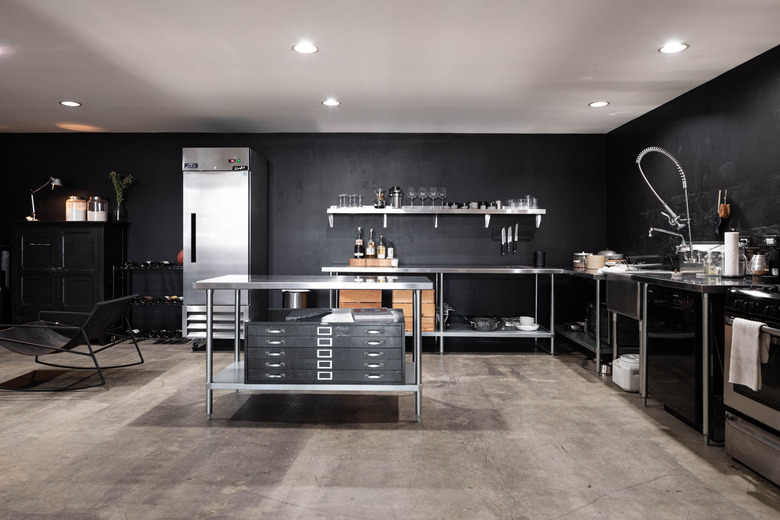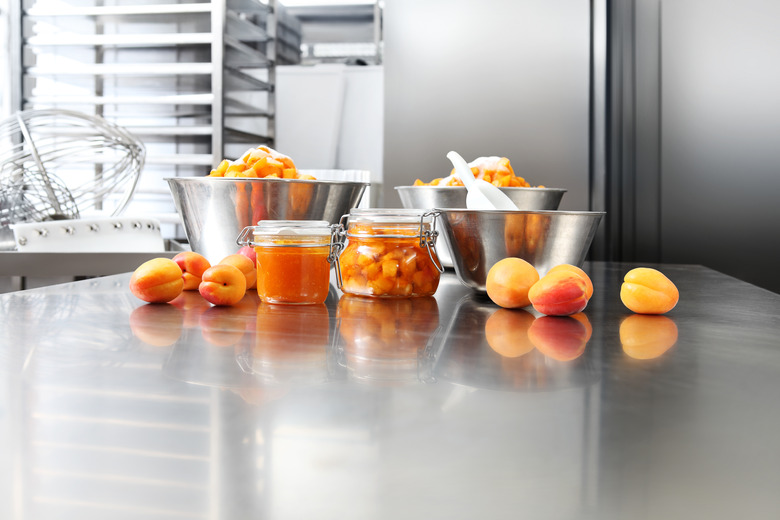Stainless Steel Kitchen Countertops: A Homeowner's Guide
For many years, stainless steel countertops were found mainly in restaurants and commercial kitchens, but they have gained popularity in recent years among homeowners looking for a combination of modern appeal and durability. If you are considering upgrading your kitchen area to include stainless steel countertops, it's a good idea to know some of the benefits — and yes, drawbacks — of bringing these worktops into your home.
Benefits of Stainless Steel
Benefits of Stainless Steel
According to Old House Journal, stainless steel has been widely used for countertops since the 1920s. There's a reason stainless steel countertops have been used for so long in commercial and restaurant kitchens — the material is about as indestructible a worktop as you can find. Stainless steel is resistant to heat, meaning you can set a hot pot right on the surface, and later, when you remove it, you won't find a mark or burn. The countertop will heat up, but the heat will stay isolated to the area where the pot is placed. Say goodbye to scorch marks!
Stainless steel is very easy to clean and is resistant to staining, as suggested by the name, because no food or liquid can penetrate the material. If you've ever watched your child spill Kool-Aid on a countertop and you've tried to remove it, this may sound like a minor miracle. Stainless steel does not harbor bacteria like other types of countertops, particularly porous materials like concrete and natural stone, making it extremely hygienic.
These are all wonderful reasons to install stainless steel countertops in your home, particularly if you consider yourself a skilled chef or just enjoy preparing food for others. Another less-practical reason stainless steel countertops have grown in recent popularity is because of the chic, modern appeal they provide to any contemporary kitchen. As an additional bonus, stainless steel is completely recyclable, allowing you to make a statement with your modern kitchen while at the same time being environmentally friendly.
Stainless Steel Drawbacks
Stainless Steel Drawbacks
While there are several advantages to having a stainless steel worktop, like with almost everything in life, there are also a few drawbacks. A new stainless steel worktop will look shiny and clean, but they easily scratch. In fact, expect to find scratches over time if you plan to use your metal counter. The counters can also become dented when you set down pots and pans and other cooking equipment, especially if you have a lower-gauge stainless steel.
Although stainless steel is hygienic and easy to clean, fingerprints and smudge marks tend to show up easily and more often on this material. If you already have stainless-steel appliances like a refrigerator in your home, you can probably attest to how easily fingerprints show up. Also, stainless steel does not give a comfortable, cozy feel to a kitchen. While some homeowners appreciate its very modern and stylish look, stainless steel can be too cold and industrial-looking for others.
One more thing about stainless steel counters — they can be loud. If you've ever worked in a restaurant or hotel kitchen, you realize how loud it can be in there, and much of the noise is due to pots and plates banging on the counters. If you're the type of person who likes to get up from bed to quietly fix a midnight snack while everyone else is sleeping, these countertops are probably not for you unless you are planning to go on a diet.
Installation and Cost
Installation and Cost
Stainless steel comes in different gauges, or thicknesses. The typical, standard gauge for a stainless-steel countertop ranges from 14 to 20, with 14 being thicker and stronger. The lower the gauge, the thicker the steel and the sturdier the counter. Fourteen-gauge stainless steel is most commonly found in commercial and restaurant kitchens, while 16- and 18-gauge steel is usually used in residential settings.
Of course, it makes sense that the thicker the gauge, the more durable the countertop and the less likely it is to scratch or dent. With a higher quality comes a higher product and installation cost. Stainless-steel countertops cost an average of $50 to $150 per square foot installed. The price depends on factors including the gauge, how much customization you have done and your location. This price range puts stainless steel among the more-expensive countertops, in the same range as marble.
Stainless steel worktops are custom manufactured. After taking measurements, a sheet of metal is cut to the specifications and placed over a wood frame. The stainless steel can be fabricated to create a backsplash, and several edge profiles are available for decorative or functional reasons. Stainless steel also comes in several varieties of finish options, including brushed, satin polish and antique matte. For residential applications, the brushed finish is often the best choice because fingerprints and scratches don't show up as easily.
For those who are handy and looking to save some money, you can start a DIY installation by taking measurements and then cutting a wood template or frame. Most metal fabrication companies will cut the stainless steel and fit it around your wood template to prepare it for installation. The installation includes fitting in the sink and sealing seams, so unless you are very handy, stainless steel counter installation is usually best left to the professionals.
Stainless Steel Cleaning and Maintenance
Stainless Steel Cleaning and Maintenance
Because a stainless steel countertop is nonporous, most basic cleaning can be accomplished with just a wet soapy towel or sponge. The nonporous material means that, unlike granite and other porous counters, liquids will simply sit on top of it instead of being absorbed. Because a stainless steel worktop will not stain, there is no need to use bleach or other products that you might use on other counter materials. Those frequent fingerprint smudges can be wiped up with soap and water, or you can try using a stainless steel cleaner or polish.
Basic cleaning can be done with soap and water, but the mess and stickiness that can develop after preparing a large meal may require the use of natural cleaning products found in most homes. These products include a combination of baking soda and vinegar. Sprinkle baking soda on the area, wipe it with vinegar and then finish up with a soapy sponge. To keep your counter's shiny finish, apply a little mineral or olive oil and then spread and buff it with a clean cloth. You can also use a stainless steel polish for this job.
Abrasive cleaning products or rough sponges should not be used on stainless steel worktops because they can scratch the surface. Surface scratches can be dulled or made to blend in by rubbing with the grain using a mild abrasive pad. Deep scratches of the sort that usually come from using sharp knives will likely require professional help to remove. Dent removal will also require the skills of a professional.

